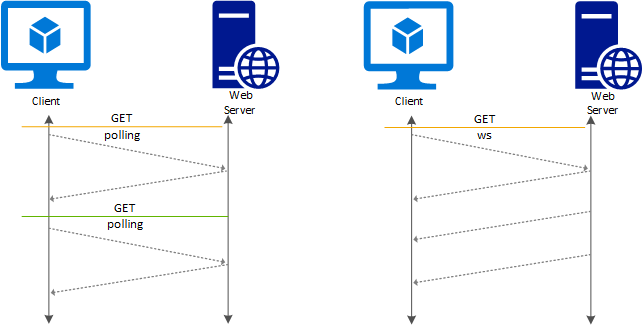
In the evolving landscape of web technologies, the need for real-time, bidirectional communication between clients and servers has become increasingly crucial. Traditional HTTP requests, while foundational to web communication, often fall short in scenarios requiring instant data exchange. Enter WebSockets, a powerful protocol that has revolutionized how we think about interaction on the web.
Understanding WebSockets
WebSockets provide a full-duplex communication channel over a single, long-lived connection, allowing data to flow freely in both directions as soon as the connection is established. This is a stark contrast to the conventional request-response model of HTTP, where each interaction requires a new connection, leading to increased latency and overhead.

The WebSockets Handshake
The magic begins with the WebSockets handshake, an upgrade from the HTTP protocol to WebSockets. This process starts with the client sending a special HTTP request, indicating its desire to establish a WebSockets connection. If the server supports WebSockets, it responds with an HTTP 101 status code (Switching Protocols), and the connection is upgraded. From this point on, the communication switches from HTTP to the WebSockets protocol, allowing for seamless, bidirectional data exchange.
WebSockets in Action: Use Cases
WebSockets shine in scenarios where real-time interaction is key. Some common use cases include:
- Chatting Applications: Instant messaging apps benefit greatly from WebSockets, enabling real-time communication between users.
- Live Feeds: News, sports updates, or stock market feeds can be instantly pushed to clients, ensuring they receive the latest information without delay.
- Multiplayer Gaming: Online games require fast, continuous data exchange to synchronize the state across all players, a task WebSockets handle with ease.
- Progress and Logging: Monitoring the progress of long-running tasks or streaming logs can be efficiently achieved using WebSockets.
Pros and Cons of WebSockets
While WebSockets offer significant advantages, they come with their own set of challenges:Pros:
- Full-Duplex Communication: Allows for simultaneous data exchange, eliminating the need for polling.
- HTTP Compatible: Easily integrates with existing web infrastructure.
- Firewall Friendly: Operates on standard web ports, making it compatible with most firewall rules.
Cons:
- Proxying Challenges: Establishing WebSocket connections through proxies can be complex.
- Load Balancing Issues: Maintaining persistent connections complicates load balancing across multiple servers.
- Statefulness: The need to maintain a connection state can hinder horizontal scaling efforts.
Alternatives to WebSockets
While WebSockets are powerful, they're not always necessary. Alternatives like long polling and Server-Sent Events (SSE) can be used when bidirectional communication isn't a strict requirement. These methods provide ways to achieve real-time communication with varying degrees of complexity and overhead.
what are some best practices for horizontally scaling websockets
Best Practices for Horizontally Scaling WebSockets
Scaling WebSockets horizontally to handle increased traffic and maintain performance is crucial for applications relying on real-time communication. Here are some best practices based on expert insights:
- Load Balancing: Implement a robust load balancing strategy to distribute WebSocket connections evenly across multiple servers. This helps prevent overloading individual servers and ensures efficient resource utilization
- State Management: Minimize server-side state to facilitate easier scaling. Consider using shared databases or in-memory caches to store session data, allowing any server to handle requests from clients without relying heavily on server-specific information
- Connection Pooling: Utilize connection pooling techniques to manage WebSocket connections efficiently. By reusing existing connections and limiting the creation of new ones, you can optimize resource usage and improve scalability
- Horizontal Scaling Architecture: Design your WebSocket application with horizontal scaling in mind from the start. Use technologies like Kubernetes or Docker Swarm to orchestrate containers across multiple nodes, enabling seamless scaling as demand increases
- Monitoring and Observability: Implement robust monitoring tools to track WebSocket performance metrics, such as connection rates, message throughput, and server load. This data is essential for identifying bottlenecks and making informed scaling decisions
- Auto-Scaling: Leverage auto-scaling capabilities provided by cloud platforms to automatically adjust resources based on real-time demand. This dynamic scaling ensures that your WebSocket infrastructure can adapt to fluctuating traffic patterns effectively
- Optimized Code: Write efficient WebSocket code that minimizes unnecessary processing and maximizes resource utilization. Avoid blocking operations that can hinder scalability and optimize algorithms for better performance under high loads
By following these best practices, you can effectively scale your WebSocket infrastructure horizontally, ensuring that your real-time applications can handle increasing user demands while maintaining optimal performance and reliability.
Conclusion
WebSockets have undeniably transformed the landscape of real-time web communication, offering a robust solution for scenarios where instant data exchange is paramount. Despite their challenges, the benefits of using WebSockets—such as reduced latency and overhead, and the ability to facilitate live, interactive experiences—make them an invaluable tool in the modern web developer's arsenal. As with any technology, the key is to understand its strengths and limitations and to choose the right tool for the job at hand.

